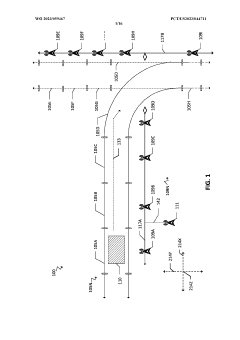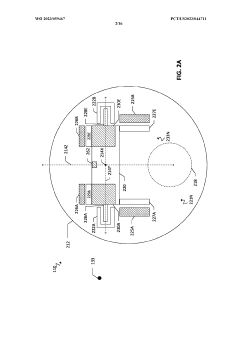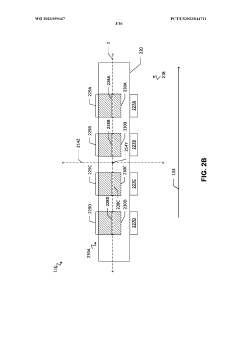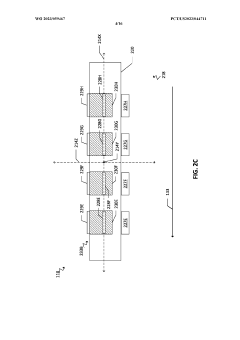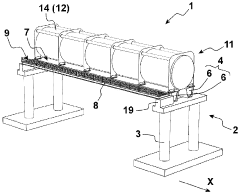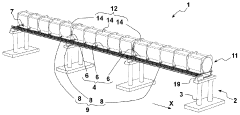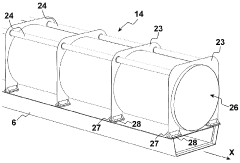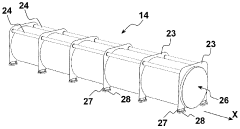Exploring Throttle Body Control in Hyperloop Systems
JUL 18, 20259 MIN READ
Generate Your Research Report Instantly with AI Agent
Patsnap Eureka helps you evaluate technical feasibility & market potential.
Hyperloop Throttle Control Background and Objectives
The Hyperloop concept, introduced by Elon Musk in 2013, represents a revolutionary approach to high-speed transportation. This innovative system proposes to transport passengers and cargo through low-pressure tubes at speeds approaching the speed of sound. At the heart of this technology lies the critical component of throttle body control, which plays a pivotal role in regulating the speed and efficiency of Hyperloop pods.
The evolution of throttle control systems in transportation has been marked by significant milestones. From the early mechanical throttles in steam engines to the electronic throttle control systems in modern vehicles, the technology has continuously advanced. The Hyperloop system, however, presents unique challenges that demand a new paradigm in throttle control.
In the context of Hyperloop, throttle body control encompasses the precise management of airflow and propulsion systems within the low-pressure tube environment. This control is essential for maintaining optimal speed, ensuring passenger comfort, and maximizing energy efficiency. The primary objective of throttle control in Hyperloop systems is to achieve seamless acceleration and deceleration while navigating the complex dynamics of near-vacuum tube travel.
The development of Hyperloop throttle control technology aims to overcome several key challenges. These include managing the extreme speeds involved, compensating for air resistance variations in the low-pressure environment, and ensuring rapid response times to maintain stability and safety. Additionally, the throttle control system must be integrated with other critical components such as the levitation and guidance systems.
Research and development in this field are driven by the need for ultra-high-speed transportation solutions that can revolutionize intercity travel. The potential benefits of successful Hyperloop implementation include drastically reduced travel times, lower energy consumption compared to traditional high-speed rail or air travel, and reduced environmental impact.
As the technology progresses, the objectives for Hyperloop throttle control systems continue to evolve. Current goals include achieving precise speed control at various stages of the journey, optimizing energy consumption, and enhancing the overall reliability and safety of the system. Future objectives may focus on further increasing top speeds, improving passenger comfort through smoother acceleration profiles, and developing more advanced predictive control algorithms.
The exploration of throttle body control in Hyperloop systems represents a convergence of various engineering disciplines, including aerodynamics, control systems, and materials science. This interdisciplinary approach is crucial for addressing the complex challenges posed by this groundbreaking transportation technology.
The evolution of throttle control systems in transportation has been marked by significant milestones. From the early mechanical throttles in steam engines to the electronic throttle control systems in modern vehicles, the technology has continuously advanced. The Hyperloop system, however, presents unique challenges that demand a new paradigm in throttle control.
In the context of Hyperloop, throttle body control encompasses the precise management of airflow and propulsion systems within the low-pressure tube environment. This control is essential for maintaining optimal speed, ensuring passenger comfort, and maximizing energy efficiency. The primary objective of throttle control in Hyperloop systems is to achieve seamless acceleration and deceleration while navigating the complex dynamics of near-vacuum tube travel.
The development of Hyperloop throttle control technology aims to overcome several key challenges. These include managing the extreme speeds involved, compensating for air resistance variations in the low-pressure environment, and ensuring rapid response times to maintain stability and safety. Additionally, the throttle control system must be integrated with other critical components such as the levitation and guidance systems.
Research and development in this field are driven by the need for ultra-high-speed transportation solutions that can revolutionize intercity travel. The potential benefits of successful Hyperloop implementation include drastically reduced travel times, lower energy consumption compared to traditional high-speed rail or air travel, and reduced environmental impact.
As the technology progresses, the objectives for Hyperloop throttle control systems continue to evolve. Current goals include achieving precise speed control at various stages of the journey, optimizing energy consumption, and enhancing the overall reliability and safety of the system. Future objectives may focus on further increasing top speeds, improving passenger comfort through smoother acceleration profiles, and developing more advanced predictive control algorithms.
The exploration of throttle body control in Hyperloop systems represents a convergence of various engineering disciplines, including aerodynamics, control systems, and materials science. This interdisciplinary approach is crucial for addressing the complex challenges posed by this groundbreaking transportation technology.
Market Analysis for Hyperloop Transportation
The Hyperloop transportation market is experiencing significant growth and attracting substantial investment as the concept moves closer to commercial reality. This revolutionary transportation system, which proposes to move passengers and cargo at near-supersonic speeds through low-pressure tubes, has the potential to disrupt traditional long-distance travel and logistics industries.
Market demand for Hyperloop technology is driven by several factors. Firstly, the increasing need for faster, more efficient transportation solutions in a globalized world is pushing governments and private entities to explore innovative alternatives. Secondly, the growing emphasis on sustainable transportation aligns well with Hyperloop's potential for low energy consumption and reduced carbon emissions. Additionally, the promise of reduced travel times between major cities could reshape urban development and economic landscapes.
The potential market size for Hyperloop transportation is substantial. While precise figures are challenging to determine due to the nascent stage of the technology, industry analysts project that the global Hyperloop market could reach tens of billions of dollars by 2030. This estimate takes into account infrastructure development, vehicle manufacturing, and operational services.
Several key market segments are emerging within the Hyperloop ecosystem. Passenger transportation is expected to be a primary focus, particularly for routes between major metropolitan areas separated by distances of 300 to 1500 kilometers. Cargo and freight transport represent another significant opportunity, with the potential to revolutionize supply chain logistics and time-sensitive deliveries.
The industry landscape is characterized by a mix of established transportation companies, tech giants, and innovative startups. Notable players include Virgin Hyperloop, Hyperloop Transportation Technologies (HTT), and TransPod, among others. These companies are not only developing the core Hyperloop technology but also working on related systems such as pod design, propulsion mechanisms, and control systems.
Geographically, North America and Europe are currently leading in Hyperloop development and testing. However, emerging economies in Asia and the Middle East are showing increasing interest, with several projects in various stages of planning and development. This global distribution of projects indicates a widespread recognition of Hyperloop's potential to address transportation challenges across diverse economic and geographic contexts.
Despite the promising outlook, the Hyperloop market faces several challenges. Regulatory frameworks for this novel transportation system are still in development, which could impact deployment timelines. Additionally, the high initial capital costs for infrastructure development present a significant barrier to entry. Public acceptance and safety concerns also need to be addressed to ensure widespread adoption.
Market demand for Hyperloop technology is driven by several factors. Firstly, the increasing need for faster, more efficient transportation solutions in a globalized world is pushing governments and private entities to explore innovative alternatives. Secondly, the growing emphasis on sustainable transportation aligns well with Hyperloop's potential for low energy consumption and reduced carbon emissions. Additionally, the promise of reduced travel times between major cities could reshape urban development and economic landscapes.
The potential market size for Hyperloop transportation is substantial. While precise figures are challenging to determine due to the nascent stage of the technology, industry analysts project that the global Hyperloop market could reach tens of billions of dollars by 2030. This estimate takes into account infrastructure development, vehicle manufacturing, and operational services.
Several key market segments are emerging within the Hyperloop ecosystem. Passenger transportation is expected to be a primary focus, particularly for routes between major metropolitan areas separated by distances of 300 to 1500 kilometers. Cargo and freight transport represent another significant opportunity, with the potential to revolutionize supply chain logistics and time-sensitive deliveries.
The industry landscape is characterized by a mix of established transportation companies, tech giants, and innovative startups. Notable players include Virgin Hyperloop, Hyperloop Transportation Technologies (HTT), and TransPod, among others. These companies are not only developing the core Hyperloop technology but also working on related systems such as pod design, propulsion mechanisms, and control systems.
Geographically, North America and Europe are currently leading in Hyperloop development and testing. However, emerging economies in Asia and the Middle East are showing increasing interest, with several projects in various stages of planning and development. This global distribution of projects indicates a widespread recognition of Hyperloop's potential to address transportation challenges across diverse economic and geographic contexts.
Despite the promising outlook, the Hyperloop market faces several challenges. Regulatory frameworks for this novel transportation system are still in development, which could impact deployment timelines. Additionally, the high initial capital costs for infrastructure development present a significant barrier to entry. Public acceptance and safety concerns also need to be addressed to ensure widespread adoption.
Current Challenges in Hyperloop Throttle Body Control
The throttle body control system in Hyperloop technology faces several significant challenges that hinder its optimal performance and reliability. One of the primary issues is the need for precise and rapid control in a high-speed, low-pressure environment. The Hyperloop's operational conditions demand extremely fast response times from the throttle body, which current control systems struggle to achieve consistently.
Another major challenge lies in the integration of the throttle body control with the overall propulsion system. The complex interactions between the throttle, compressor, and other propulsion components require sophisticated coordination and synchronization. Current control algorithms often fall short in managing these intricate relationships, leading to suboptimal performance and potential system instabilities.
The extreme operating conditions of the Hyperloop also pose significant challenges for throttle body control. The near-vacuum environment and high-speed travel create unique thermal management issues. Existing control systems struggle to maintain optimal throttle body performance under these extreme temperature fluctuations, potentially compromising system efficiency and safety.
Furthermore, the need for fail-safe operation and redundancy in critical systems like throttle body control presents additional challenges. Current designs often lack robust fault-tolerance mechanisms, leaving the system vulnerable to single points of failure. This deficiency raises concerns about the overall reliability and safety of Hyperloop systems, particularly during emergency scenarios or unexpected environmental conditions.
The scalability of throttle body control systems for different Hyperloop configurations and pod sizes also presents a significant challenge. Current control strategies often lack the flexibility to adapt to varying system requirements, limiting their applicability across different Hyperloop designs and operational scenarios.
Additionally, the energy efficiency of throttle body control systems remains a critical concern. Existing control algorithms may not optimize power consumption effectively, potentially impacting the overall energy efficiency of the Hyperloop system. This challenge becomes particularly significant when considering the long-term operational costs and environmental impact of Hyperloop transportation.
Lastly, the integration of advanced sensors and real-time data processing for throttle body control poses substantial technical hurdles. Current systems often struggle to effectively utilize the vast amounts of data generated during Hyperloop operation, limiting their ability to make rapid, informed adjustments to throttle body performance. Overcoming these challenges will require significant advancements in sensor technology, data processing algorithms, and control system architectures.
Another major challenge lies in the integration of the throttle body control with the overall propulsion system. The complex interactions between the throttle, compressor, and other propulsion components require sophisticated coordination and synchronization. Current control algorithms often fall short in managing these intricate relationships, leading to suboptimal performance and potential system instabilities.
The extreme operating conditions of the Hyperloop also pose significant challenges for throttle body control. The near-vacuum environment and high-speed travel create unique thermal management issues. Existing control systems struggle to maintain optimal throttle body performance under these extreme temperature fluctuations, potentially compromising system efficiency and safety.
Furthermore, the need for fail-safe operation and redundancy in critical systems like throttle body control presents additional challenges. Current designs often lack robust fault-tolerance mechanisms, leaving the system vulnerable to single points of failure. This deficiency raises concerns about the overall reliability and safety of Hyperloop systems, particularly during emergency scenarios or unexpected environmental conditions.
The scalability of throttle body control systems for different Hyperloop configurations and pod sizes also presents a significant challenge. Current control strategies often lack the flexibility to adapt to varying system requirements, limiting their applicability across different Hyperloop designs and operational scenarios.
Additionally, the energy efficiency of throttle body control systems remains a critical concern. Existing control algorithms may not optimize power consumption effectively, potentially impacting the overall energy efficiency of the Hyperloop system. This challenge becomes particularly significant when considering the long-term operational costs and environmental impact of Hyperloop transportation.
Lastly, the integration of advanced sensors and real-time data processing for throttle body control poses substantial technical hurdles. Current systems often struggle to effectively utilize the vast amounts of data generated during Hyperloop operation, limiting their ability to make rapid, informed adjustments to throttle body performance. Overcoming these challenges will require significant advancements in sensor technology, data processing algorithms, and control system architectures.
Existing Throttle Body Control Solutions for Hyperloop
01 Electronic throttle control systems
Electronic throttle control systems use sensors and actuators to regulate airflow into the engine. These systems replace traditional mechanical linkages with electronic components for more precise control of engine performance and fuel efficiency.- Electronic throttle control systems: Electronic throttle control systems use sensors and actuators to regulate airflow into the engine. These systems replace traditional mechanical linkages with electronic components for more precise control of engine performance and fuel efficiency.
- Throttle body design and construction: Innovations in throttle body design focus on improving airflow characteristics and reducing manufacturing costs. This includes advancements in materials, shape optimization, and integration of additional components like sensors or actuators within the throttle body assembly.
- Throttle position sensors and feedback systems: Advanced throttle position sensors provide accurate feedback on throttle plate position to the engine control unit. These sensors, often using Hall effect or potentiometer technology, enable precise control of air-fuel mixture and improved engine response.
- Idle air control and bypass systems: Idle air control systems manage engine speed during idle conditions by bypassing the main throttle plate. These systems may use separate air passages or integrated valves within the throttle body to maintain stable idle speed and improve cold start performance.
- Integration with engine management systems: Modern throttle bodies are increasingly integrated with broader engine management systems. This integration allows for more sophisticated control strategies, including adaptive learning, diagnostic capabilities, and coordination with other engine subsystems for optimal performance and emissions control.
02 Throttle body design and construction
Innovations in throttle body design focus on improving airflow characteristics and reducing manufacturing costs. This includes advancements in materials, shape optimization, and integration of additional components like idle air control valves.Expand Specific Solutions03 Throttle position sensors and feedback systems
Advanced throttle position sensors provide accurate feedback to the engine control unit. These sensors help maintain optimal air-fuel ratios and improve overall engine performance by enabling precise throttle control based on various operating conditions.Expand Specific Solutions04 Throttle body cleaning and maintenance
Methods and devices for cleaning and maintaining throttle bodies to ensure optimal performance. This includes specialized cleaning solutions, tools, and procedures to remove carbon deposits and other contaminants that can affect throttle operation.Expand Specific Solutions05 Integration with engine management systems
Advanced throttle control systems are increasingly integrated with broader engine management systems. This integration allows for more sophisticated control strategies, including adaptive learning, improved fuel economy, and enhanced emissions control.Expand Specific Solutions
Key Players in Hyperloop and Throttle Control Industries
The exploration of throttle body control in Hyperloop systems represents an emerging technological frontier in advanced transportation. This field is in its early developmental stages, with the market size still relatively small but showing significant growth potential. The technology's maturity is evolving rapidly, driven by innovative companies like Hyperloop Technologies, Inc., which is pioneering high-speed vacuum tube transportation. Traditional automotive giants such as GM, Toyota, and Ford are also likely to contribute their expertise in throttle control systems, potentially adapting their technologies for Hyperloop applications. Universities like MIT and the University of Washington are expected to play crucial roles in advancing the fundamental research necessary for this cutting-edge technology.
GM Global Technology Operations LLC
Technical Solution: GM has adapted its extensive experience in automotive throttle body control to the hyperloop context. Their system employs a modified version of their electronic throttle control (ETC) technology, which has been optimized for the unique requirements of hyperloop propulsion. The system uses a brushless DC motor for precise throttle actuation and incorporates advanced sensor fusion techniques to monitor and adjust airflow in real-time[2]. GM's approach also includes adaptive learning algorithms that can optimize throttle response based on changing environmental conditions within the hyperloop tube[4].
Strengths: Vast experience in vehicle control systems, robust manufacturing capabilities, and established reliability testing protocols. Weaknesses: May require significant adaptation of existing automotive technologies to meet hyperloop-specific challenges.
Toyota Motor Corp.
Technical Solution: Toyota has developed a hybrid approach to throttle body control for hyperloop systems, leveraging its expertise in both electric and combustion engine technologies. Their system integrates a high-response electric actuator with a mechanically-linked backup system for enhanced reliability. Toyota's control unit utilizes predictive modeling and machine learning algorithms to anticipate required throttle adjustments based on the hyperloop pod's trajectory and speed profile[5]. The company has also implemented a novel thermal management system to ensure consistent throttle performance under the extreme temperature variations experienced in hyperloop operations[6].
Strengths: Innovative hybrid control approach, advanced predictive algorithms, and expertise in thermal management. Weaknesses: Potential complexity in integrating electric and mechanical systems in the hyperloop environment.
Innovative Throttle Control Patents for Hyperloop Systems
System and method for hyperloop motion control and state estimation
PatentWO2023059467A1
Innovation
- A system and method for hyperloop motion control and state estimation using a processor that receives sensor data to generate state estimations and linearized commands for electromagnetic assemblies, ensuring accurate positioning and orientation, and detecting faults to update commands and maintain safe operation.
Transportation structure
PatentWO2023161679A1
Innovation
- A substructure composed of piers and girders supports the tube segments, with shims placed between the substructure and the tube segments to compensate for deflection, ensuring the tube segments remain straight and minimizing deflection to less than 10mm, allowing pods to travel smoothly under low air pressure with reduced air friction.
Safety and Reliability Considerations in Hyperloop Systems
Safety and reliability are paramount considerations in the development and operation of Hyperloop systems. The high-speed nature of Hyperloop transportation, coupled with its enclosed environment, necessitates rigorous safety protocols and robust reliability measures. One critical aspect of safety in Hyperloop systems is the implementation of redundant systems for critical components, including throttle body control mechanisms. These redundancies ensure that in the event of a primary system failure, secondary systems can maintain safe operation.
Emergency response systems play a vital role in Hyperloop safety. These include rapid deceleration mechanisms, emergency egress procedures, and fail-safe pod designs. Advanced sensor networks throughout the Hyperloop infrastructure continuously monitor system parameters, detecting anomalies and triggering appropriate responses to prevent potential accidents. The integration of artificial intelligence and machine learning algorithms enhances the system's ability to predict and mitigate risks proactively.
Reliability in Hyperloop systems is achieved through comprehensive testing and validation processes. Simulations and physical prototypes are used to assess the performance of throttle body control systems under various operational conditions, including extreme scenarios. Long-term durability testing ensures that components can withstand the rigors of continuous high-speed operation. Additionally, predictive maintenance strategies, leveraging real-time data analytics, help identify potential issues before they escalate into system failures.
The vacuum environment of Hyperloop tubes presents unique challenges for safety and reliability. Maintaining tube integrity is crucial, as any breach could result in rapid pressure changes. Advanced materials and construction techniques are employed to ensure the structural integrity of the tube system, while sophisticated pressure management systems maintain the required low-pressure environment. Regular inspections and non-destructive testing methods are utilized to detect any potential weaknesses in the tube structure.
Human factors are also considered in Hyperloop safety design. Passenger comfort and well-being during high-speed travel are addressed through careful pod design, including considerations for acceleration forces, noise reduction, and emergency scenarios. Crew training programs focus on both routine operations and emergency response procedures, ensuring that human operators are prepared to handle any situation that may arise.
Regulatory compliance and standardization efforts are ongoing in the Hyperloop industry to establish comprehensive safety and reliability guidelines. These efforts involve collaboration between industry stakeholders, government agencies, and international organizations to develop standards that address the unique aspects of Hyperloop technology. As the technology evolves, these standards will continue to be refined to ensure the highest levels of safety and reliability in Hyperloop systems.
Emergency response systems play a vital role in Hyperloop safety. These include rapid deceleration mechanisms, emergency egress procedures, and fail-safe pod designs. Advanced sensor networks throughout the Hyperloop infrastructure continuously monitor system parameters, detecting anomalies and triggering appropriate responses to prevent potential accidents. The integration of artificial intelligence and machine learning algorithms enhances the system's ability to predict and mitigate risks proactively.
Reliability in Hyperloop systems is achieved through comprehensive testing and validation processes. Simulations and physical prototypes are used to assess the performance of throttle body control systems under various operational conditions, including extreme scenarios. Long-term durability testing ensures that components can withstand the rigors of continuous high-speed operation. Additionally, predictive maintenance strategies, leveraging real-time data analytics, help identify potential issues before they escalate into system failures.
The vacuum environment of Hyperloop tubes presents unique challenges for safety and reliability. Maintaining tube integrity is crucial, as any breach could result in rapid pressure changes. Advanced materials and construction techniques are employed to ensure the structural integrity of the tube system, while sophisticated pressure management systems maintain the required low-pressure environment. Regular inspections and non-destructive testing methods are utilized to detect any potential weaknesses in the tube structure.
Human factors are also considered in Hyperloop safety design. Passenger comfort and well-being during high-speed travel are addressed through careful pod design, including considerations for acceleration forces, noise reduction, and emergency scenarios. Crew training programs focus on both routine operations and emergency response procedures, ensuring that human operators are prepared to handle any situation that may arise.
Regulatory compliance and standardization efforts are ongoing in the Hyperloop industry to establish comprehensive safety and reliability guidelines. These efforts involve collaboration between industry stakeholders, government agencies, and international organizations to develop standards that address the unique aspects of Hyperloop technology. As the technology evolves, these standards will continue to be refined to ensure the highest levels of safety and reliability in Hyperloop systems.
Environmental Impact of Hyperloop Transportation
The environmental impact of Hyperloop transportation systems, particularly in relation to throttle body control, is a crucial aspect to consider in the development and implementation of this innovative technology. Hyperloop systems, with their potential for high-speed, low-energy transportation, offer significant environmental benefits compared to traditional modes of transport.
One of the primary environmental advantages of Hyperloop systems is their potential for reduced carbon emissions. By utilizing electric propulsion and operating in a low-pressure environment, Hyperloop pods can achieve high speeds with minimal energy consumption. The precise control of throttle bodies in these systems plays a vital role in optimizing energy efficiency, further reducing the overall carbon footprint of transportation.
Air quality improvements are another significant environmental benefit associated with Hyperloop technology. Unlike conventional transportation methods that rely on combustion engines, Hyperloop systems produce zero direct emissions during operation. This characteristic is particularly valuable in urban areas where air pollution from transportation is a major concern.
The land use impact of Hyperloop systems is also noteworthy. The elevated or underground nature of Hyperloop infrastructure minimizes land requirements compared to traditional rail or highway systems. This reduced footprint can help preserve natural habitats and agricultural lands, contributing to biodiversity conservation and sustainable land use practices.
Noise pollution, a common environmental issue with high-speed transportation, is significantly mitigated in Hyperloop systems. The enclosed tube design and the use of magnetic levitation technology result in minimal noise generation during operation. This feature is particularly beneficial for communities located near transportation corridors, enhancing quality of life and reducing disturbances to wildlife.
Water conservation is another environmental aspect where Hyperloop systems excel. Unlike traditional transportation methods that may require significant water usage for maintenance or cooling, Hyperloop's closed-loop system minimizes water consumption. This characteristic is particularly valuable in water-scarce regions, contributing to overall water resource management.
The potential for renewable energy integration further enhances the environmental profile of Hyperloop systems. The extensive surface area of Hyperloop tubes provides an opportunity for solar panel installation, potentially allowing the system to generate a portion of its own energy needs. This integration of renewable energy sources can further reduce the system's reliance on fossil fuels and decrease its overall environmental impact.
In conclusion, the environmental impact of Hyperloop transportation, particularly when considering the role of throttle body control in optimizing system efficiency, presents a promising outlook for sustainable transportation. As the technology continues to develop, ongoing research and innovation in throttle body control and other key components will be crucial in maximizing these environmental benefits and addressing any potential challenges that may arise.
One of the primary environmental advantages of Hyperloop systems is their potential for reduced carbon emissions. By utilizing electric propulsion and operating in a low-pressure environment, Hyperloop pods can achieve high speeds with minimal energy consumption. The precise control of throttle bodies in these systems plays a vital role in optimizing energy efficiency, further reducing the overall carbon footprint of transportation.
Air quality improvements are another significant environmental benefit associated with Hyperloop technology. Unlike conventional transportation methods that rely on combustion engines, Hyperloop systems produce zero direct emissions during operation. This characteristic is particularly valuable in urban areas where air pollution from transportation is a major concern.
The land use impact of Hyperloop systems is also noteworthy. The elevated or underground nature of Hyperloop infrastructure minimizes land requirements compared to traditional rail or highway systems. This reduced footprint can help preserve natural habitats and agricultural lands, contributing to biodiversity conservation and sustainable land use practices.
Noise pollution, a common environmental issue with high-speed transportation, is significantly mitigated in Hyperloop systems. The enclosed tube design and the use of magnetic levitation technology result in minimal noise generation during operation. This feature is particularly beneficial for communities located near transportation corridors, enhancing quality of life and reducing disturbances to wildlife.
Water conservation is another environmental aspect where Hyperloop systems excel. Unlike traditional transportation methods that may require significant water usage for maintenance or cooling, Hyperloop's closed-loop system minimizes water consumption. This characteristic is particularly valuable in water-scarce regions, contributing to overall water resource management.
The potential for renewable energy integration further enhances the environmental profile of Hyperloop systems. The extensive surface area of Hyperloop tubes provides an opportunity for solar panel installation, potentially allowing the system to generate a portion of its own energy needs. This integration of renewable energy sources can further reduce the system's reliance on fossil fuels and decrease its overall environmental impact.
In conclusion, the environmental impact of Hyperloop transportation, particularly when considering the role of throttle body control in optimizing system efficiency, presents a promising outlook for sustainable transportation. As the technology continues to develop, ongoing research and innovation in throttle body control and other key components will be crucial in maximizing these environmental benefits and addressing any potential challenges that may arise.
Unlock deeper insights with Patsnap Eureka Quick Research — get a full tech report to explore trends and direct your research. Try now!
Generate Your Research Report Instantly with AI Agent
Supercharge your innovation with Patsnap Eureka AI Agent Platform!
